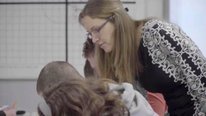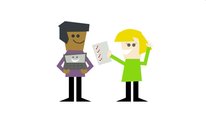- Joanna Totino
- Bay Area Science Project, Director - Co-PI, NSF-ITEST EPICC
- Educational Pathways into College and Career
- Lawrence Hall of Science
- Kathryn Quigley
- https://www.linkedin.com/in/kathryn-chong-quigley-786b6943?trk=nav_responsive_tab_profile
- Producer and Media Lead
- Educational Pathways into College and Career
- Lawrence Hall of Science
Educational Pathways into College and Career
NSF Awards: 1433677
EPICC incorporates solar technology, engineering, science, mathematics, college advising, leadership skills and service learning. The STEM content will include four major components: 1) innovative solar energy technology; 2) integrated mathematics for application of energy systems; 3) engineering; and 4) global energy issues. The service learning element will be based around a single large-scale project: students will design and build a solar suitcase, which functions as a stand-alone renewable energy system that can light a room and charge equipment such as cell phones, headlamps and e-readers. Through our solar partner students will make contact with a community in the developing world, learning about their needs and challenges. They will then design a solar energy system that fits the particular local context, requiring students to produce engineering designs for the real world. After designing and building the systems, the solar suitcases will be shared with schools, orphanages and community centers in the developing world that lack light and power. Through this project, EPICC students will create a concrete product that can transform the lives of their partner community. Students will see first-hand how what they are learning in school can have a positive impact on the world around them, which will motivate them to remain in school, to persevere in science courses, and pursue a STEM degree in college.
Educational Pathways into College and Career
NSF Awards: 1433677
EPICC incorporates solar technology, engineering, science, mathematics, college advising, leadership skills and service learning. The STEM content will include four major components: 1) innovative solar energy technology; 2) integrated mathematics for application of energy systems; 3) engineering; and 4) global energy issues. The service learning element will be based around a single large-scale project: students will design and build a solar suitcase, which functions as a stand-alone renewable energy system that can light a room and charge equipment such as cell phones, headlamps and e-readers. Through our solar partner students will make contact with a community in the developing world, learning about their needs and challenges. They will then design a solar energy system that fits the particular local context, requiring students to produce engineering designs for the real world. After designing and building the systems, the solar suitcases will be shared with schools, orphanages and community centers in the developing world that lack light and power. Through this project, EPICC students will create a concrete product that can transform the lives of their partner community. Students will see first-hand how what they are learning in school can have a positive impact on the world around them, which will motivate them to remain in school, to persevere in science courses, and pursue a STEM degree in college.
-
 NSF INCLUDES: Building upon CAHSI's Success
NSF INCLUDES: Building upon CAHSI's Success
Marjorie Zatz
-
 Scaling Up a Successful STEM Transfer Model
Scaling Up a Successful STEM Transfer Model
Mark Filowitz
-
 FIRST TWO: Improving STEM Persistence in the First Two Years
FIRST TWO: Improving STEM Persistence in the First Two Years
Kathryn Williamson
-
 Early STEM Engagement for Minority Males (eSEM)
Early STEM Engagement for Minority Males (eSEM)
Cindy Ziker
-
 Regional Collaboration to Strengthen and Expand STEM RECESS
Regional Collaboration to Strengthen and Expand STEM RECESS
Katherine Nielsen
-
 CIRTL INCLUDES: Highlights from the S. CA Regional Collab.
CIRTL INCLUDES: Highlights from the S. CA Regional Collab.
Jessica Gregg
6102 Views
Continue the discussion of this presentation on the Multiplex. Go to Multiplex
6102 Views
presentation
has been viewed
Related videos you might be interested in...
-
 NSF INCLUDES: Building upon CAHSI's Success
NSF INCLUDES: Building upon CAHSI's Success
Marjorie Zatz
-
 Scaling Up a Successful STEM Transfer Model
Scaling Up a Successful STEM Transfer Model
Mark Filowitz
-
 FIRST TWO: Improving STEM Persistence in the First Two Years
FIRST TWO: Improving STEM Persistence in the First Two Years
Kathryn Williamson
-
 Early STEM Engagement for Minority Males (eSEM)
Early STEM Engagement for Minority Males (eSEM)
Cindy Ziker
-
 Regional Collaboration to Strengthen and Expand STEM RECESS
Regional Collaboration to Strengthen and Expand STEM RECESS
Katherine Nielsen
-
 CIRTL INCLUDES: Highlights from the S. CA Regional Collab.
CIRTL INCLUDES: Highlights from the S. CA Regional Collab.
Jessica Gregg


Joanna Totino
Bay Area Science Project, Director - Co-PI, NSF-ITEST EPICC
Welcome! Our video highlights our high school STEM service-learning model. In conjunction with the model’s STEM curriculum, we have developed an accompanying youth leadership and college and career curriculum. We have piloted these curriculums in a summer bridge academy the last two years. A school could establish this project as a semester-long afterschool program or as part of its science or engineering courses.
*Could you see this project existing at one of your high schools, and if so, would you envision it as part of an existing course, an after-school class, or a summer bridge academy?
*If you offer a STEM program at your school do you have the capacity to also offer college and career curriculum alongside it?
*Have you found that students’ confidence and persistence in STEM has been enhanced when accompanied with a service-learning project?
We look forward to your comments and questions about the project, curriculum, partnerships, research and more.
Marcelo Worsley
Assistant Professor
Joanna, thank you for sharing this project. It looks like students really got a lot of of the experience. Do you all currently have plans/strategies for helping the students go deeper in their STEM learning? I imagine that students came up with additional questions and ideas during the course of the service-learning experience, and may want to find other ways to learn more STEM. If you haven't already done so, you might find the RECESS project (http://stemforall2017.videohall.com/presentatio...) to be an useful partner in this regard.
Joanna Totino
Bay Area Science Project, Director - Co-PI, NSF-ITEST EPICC
Thanks Marcelo, Yes It would be great if the students teachers' could follow-up during the year with students questions and go even deeper. Thanks for sharing the video I am familiar with RECESS and colleagues with the presenter. Great work they are doing on a large scale.
Michael Lach
Director of STEM Policy and Strategic Initiatives
Very cool stuff! I really appreciate how you've thought about how this fits into the school--as a summer bridge or course/course supplement. What would you say are the essential components of this model if you were going to transplant it to another school or location? What's most important to making this work happen?
Joanna Totino
Bay Area Science Project, Director - Co-PI, NSF-ITEST EPICC
The essential components are youth leadership, working on identity, resiliency and decision making with students and college and career access curriculum, and finally the service learning.
Lauren Amos
Associate Director
A fascinating project! I would have loved to participate in a program like this in high school. Given the interdisciplinary nature of the program and as you look forward to expanding beyond Oakland schools, what kind of instructional capacity would a school need to have in place to implement your program effectively?
Joanna Totino
Bay Area Science Project, Director - Co-PI, NSF-ITEST EPICC
Thank you. a school would need a couple of teachers interested in doing this. Science, math, engineering teachers. also someone you could do leadership and college and career info session with students. This could come from staff or local partnerships. Also the school would need partnerships with their local community college for dual enrollment if held after-school and summer. Partnerships that offer students college credit at no cost.
Further posting is closed as the showcase has ended.